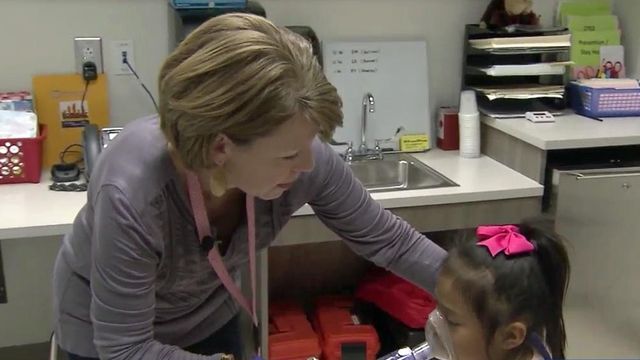Study: Need for school nurses growing in NC, could cost $79M a year
The need for nurses in North Carolina public schools is growing, but the state would need to dedicate up to $79 million a year to meet the recommended school nurse-to-student ratio, according to a new study released Monday by the General Assembly’s Program Evaluation Division.
Fewer than half of North Carolina's school districts (46 of 115) meet the ratio of one school nurse for every 750 students, as recommended by the National Association of School Nurses and State Board of Education.
North Carolina has, on average, one school nurse for every 1,086 public school students. The ratios range from as low as 319 students to as high as 2,242 students. The average nurse covers two to three schools, but some cover as many as six. Five school systems in the state have one nurse dedicated to every school (Edenton/Chowan, Kannapolis City, Pamlico County, Roanoke Rapids City and Thomasville City), according to the study.
Other highlights from the study include:
- The need for school nurses is growing due to increased attendance by exceptional children and students with chronic conditions as well as laws and policies expanding the health care responsibilities of schools.
- Achieving either the 1:750 ratio or providing one nurse in every school would cost between $45 million and $79 million annually.
- Approximately 60 percent of all medical procedures conducted in schools are performed by school employees who are not nurses. As a result, students are vulnerable to errors and gaps in emergency medical care, and funding intended for education is being used to subsidize health care.
- Unlike other school-based services, such as speech therapy, few school districts file for Medicaid reimbursement for nursing services because, under the current Medicaid State Plan, a Registered Nurse must provide the care as ordered by a physician as part of an Individual Education Plan for the student.
- The General Assembly should direct the State Board of Education to formulate a new goal for school nurse staffing levels and a strategic plan to meet those levels.
In many North Carolina public schools, school staff have to provide medical care to students. Each school nurse trains staff on how to administer first aid and how to give medicines, but the list of medical needs in modern classrooms is growing longer. In the past 15 years, the North Carolina General Assembly has passed legislation related to chronic conditions such as asthma, diabetes, and severe allergies, further expanding the roles and responsibilities of school nurses.
Research from the N.C. Department of Health and Human Services shows the average classroom has:
- Two students on medication
- Two with asthma
- One with an attention deficit disorder
- One with a life-threatening allergy
- One student with a less common health condition, such as cancer, a feeding tube or a bleeding issue.
During the 2015-16 school year, North Carolina public school nurses had 2,220,622 student encounters. More than 9 percent of the total student population received medication at school, and nurses helped 11,512 students with complex procedures, such as using an insulin pump, feeding tube or catheter. Nurses provided 396,199 counseling sessions to students regarding health, mental health and emotional issues, including screening for suicide risk.
Unlike local school systems, charter schools are not required to make the services of a registered nurse available in planning and caring for students with complex health needs. About 16 percent of charter schools in the state report having access to a registered nurse at least part-time.
The study released Monday was completed last May, but its release was delayed until a Program Evaluation Division committee could be appointed this month.












